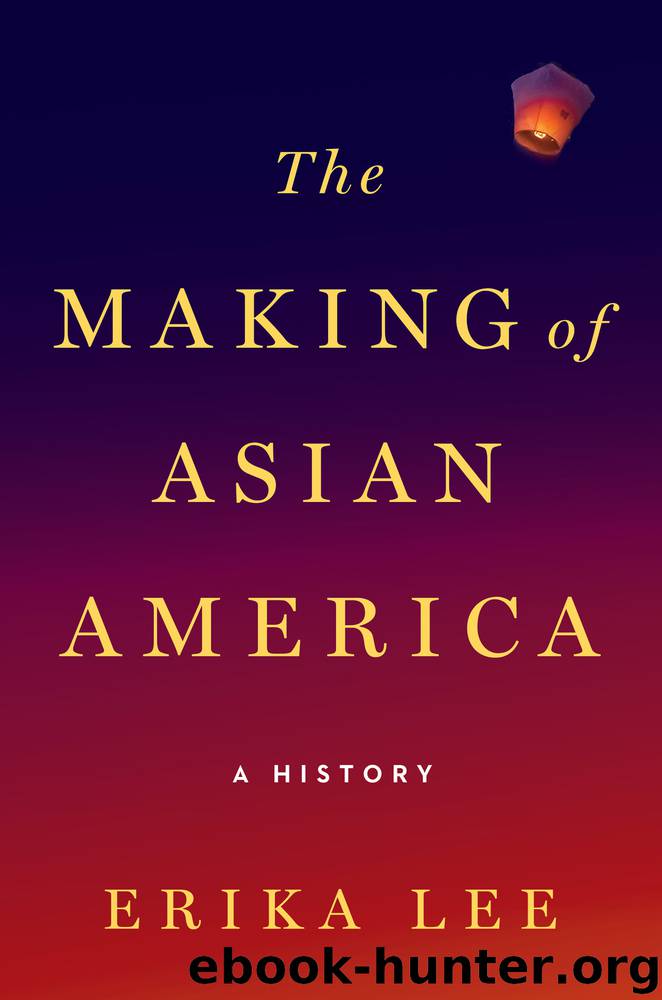The Making of Asian America by Erika Lee

Author:Erika Lee
Language: eng
Format: epub
Publisher: Simon & Schuster
47. Chiyoko Toguchi and Charles Swartz wedding portrait.
The lives of many Japanese war brides in the United States did not always match these positive media portrayals. Cut off from their families and support systems, they often felt like strangers in their new homes. In 1966, Chiyoko Toguchi Swartz left her home in Okinawa with Charles Swartz, her American soldier husband, and their daughter. Fear and anxiety overwhelmed her as she prepared to leave her home forever. In the few suitcases she could bring with her, Chiyoko packed a couple of kimonos, a small number of photographs, and a Japanese-language parenting book. When they arrived in the United States, the Swartzes stood out as oddities and even encountered lingering anti-Japanese sentiment. As Chiyoko raised her children among strangers in a new land, she came to rely on the Japanese parenting book that she had brought from home. Providing detailed advice and home remedies in Japanese, the book became a source of comfort, as well as a source of information. The Swartzes eventually settled in the Los Angeles area, where Chiyoko made new friendships in her English-language classes and became involved in the Japanese American church and the local Okinawan club. Her keepsakes from home, including the Japanese parenting book, remained an important resource and treasured family memento throughout her life.55
• • •
Korea was another site of expanding U.S. power after the war. Following Japan’s defeat in 1945, Korea was liberated as an independent nation following thirty-five years of Japanese colonial rule. But when a civil war broke out and the new government appeared to be leaning toward communism, the United States exercised its Cold War policy of containment and intervened to militarily occupy what is now known as South Korea. With the Soviet Union and the People’s Republic of China supporting the communist North Korea, the Korean War dragged on until 1953 and ended with a divided Korea. South Korea emerged from the war almost entirely reliant on the United States for its economic survival and military protection. The war also turned countless Koreans into refugees, leading many to seek safety abroad.56
Some came to the United States, especially two new groups of immigrants: adoptees and military brides. (The latter were so named to identify their immigration as a result of the ongoing U.S. military presence in the country that lasted long after the end of the Korean War.)57 Since 1945, troops have regularly been deployed to South Korea to protect U.S. interests in the region. Some relationships between Korean women and U.S. military personnel—sometimes begun in the “camptowns” established near U.S. military bases where prostitution and other illicit businesses were supported and regulated by the U.S. military—ended in marriage. Cho Soonyi was a young woman at the end of World War II when American soldiers and goods became ubiquitous in the country. The soldiers began to “control everything,” she remembered. Soon there were American goods in the country and even more soldiers who brought with them a distinctive American culture. The
Download
This site does not store any files on its server. We only index and link to content provided by other sites. Please contact the content providers to delete copyright contents if any and email us, we'll remove relevant links or contents immediately.
| African-American Studies | Asian American Studies |
| Disabled | Ethnic Studies |
| Hispanic American Studies | LGBT |
| Minority Studies | Native American Studies |
Cecilia; Or, Memoirs of an Heiress — Volume 1 by Fanny Burney(31320)
Cecilia; Or, Memoirs of an Heiress — Volume 3 by Fanny Burney(30927)
Cecilia; Or, Memoirs of an Heiress — Volume 2 by Fanny Burney(30883)
The Great Music City by Andrea Baker(21137)
We're Going to Need More Wine by Gabrielle Union(18062)
Bombshells: Glamour Girls of a Lifetime by Sullivan Steve(13098)
Pimp by Iceberg Slim(12920)
All the Missing Girls by Megan Miranda(12737)
Fifty Shades Freed by E L James(12442)
Norse Mythology by Gaiman Neil(11868)
Talking to Strangers by Malcolm Gladwell(11852)
Crazy Rich Asians by Kevin Kwan(8340)
Mindhunter: Inside the FBI's Elite Serial Crime Unit by John E. Douglas & Mark Olshaker(7823)
The Lost Art of Listening by Michael P. Nichols(6457)
Enlightenment Now: The Case for Reason, Science, Humanism, and Progress by Steven Pinker(6400)
Bad Blood by John Carreyrou(5760)
The Four Agreements by Don Miguel Ruiz(5500)
Weapons of Math Destruction by Cathy O'Neil(5027)
We Need to Talk by Celeste Headlee(4857)
